Victorious Ones: Jain Images of Perfection
A virtual tour of the Exhibition at
Rubin Museum of Art, New York City
"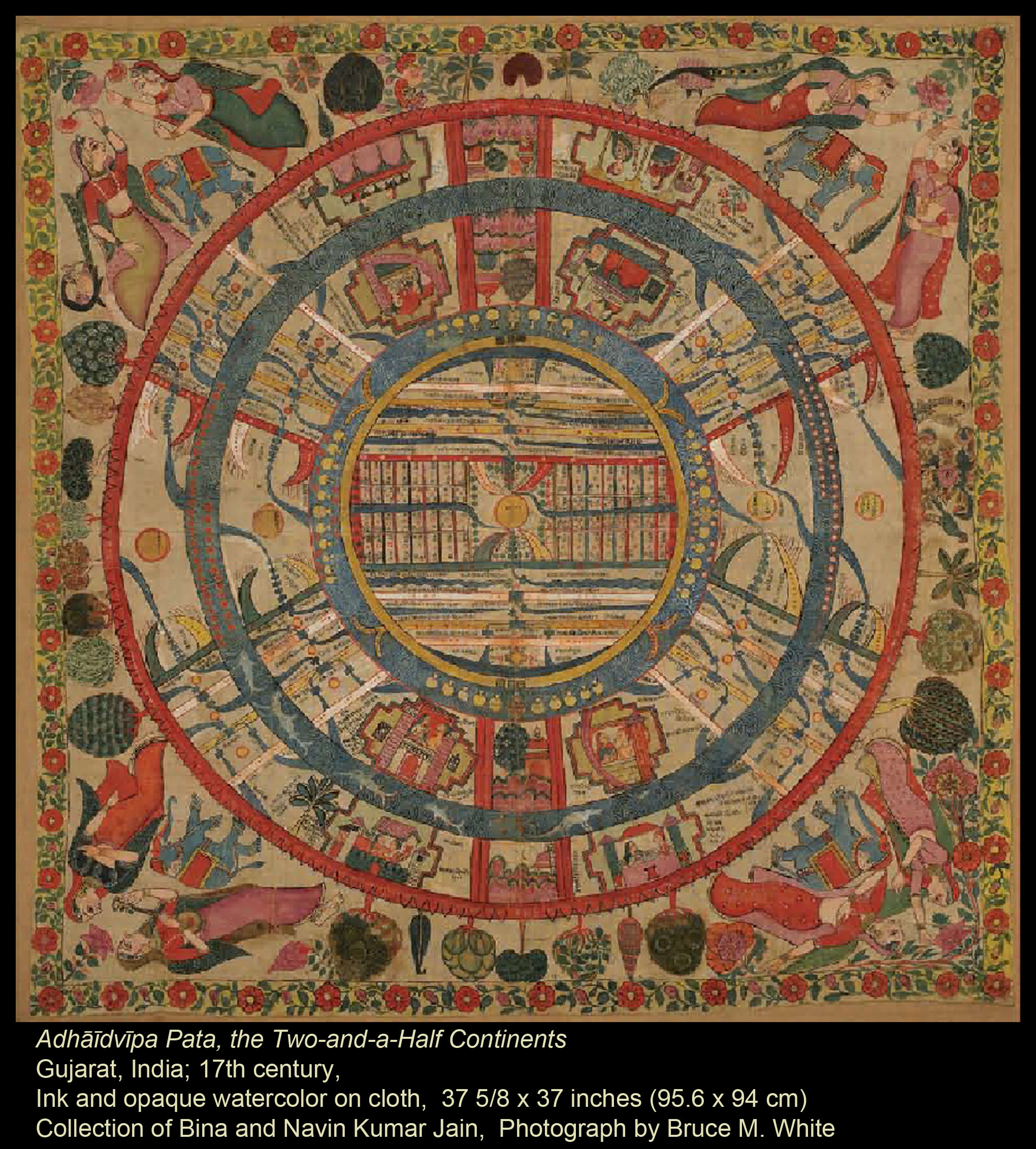
As with all Indian religious traditions, salvation co mes for the Jains through personal activity alone. They hold that all beings transmigrate through countless lifetimes, ignorantly chasing selfish and therefore, violent pursuits. Only those who have mastered the Jain path perceive reality as it is, while others stumble in semidarkness.
Jain founders preached a doctrine of ra dica l renunciation from the world that emphasized not only abstinence but also the intrinsic value of all life (from the life of the very smallest creature that we can not even see to our own lives). For ordinary men and women, they stressed the importance of living by strict ethical rules that encompass everything we do, from raising our families to conducting business. Jains practice nonviolence in all aspects of their lives and can serve as a model for us in an increasingly violent world.
Jains have given the world a corpus of tremendously beautiful art, which I have loved since I began collecting many years ago. I am pleased that Phyllis Granoff, a brilliant scholar and dear friend, agreed to curate an exhibition on Jain art. We might all inspire to learn something from Jains as we contemplate their art.”
- Donald Rubin, Founder of Rubin Museum, Catalogue of Victorious Ones: Jain Images of Perfection.
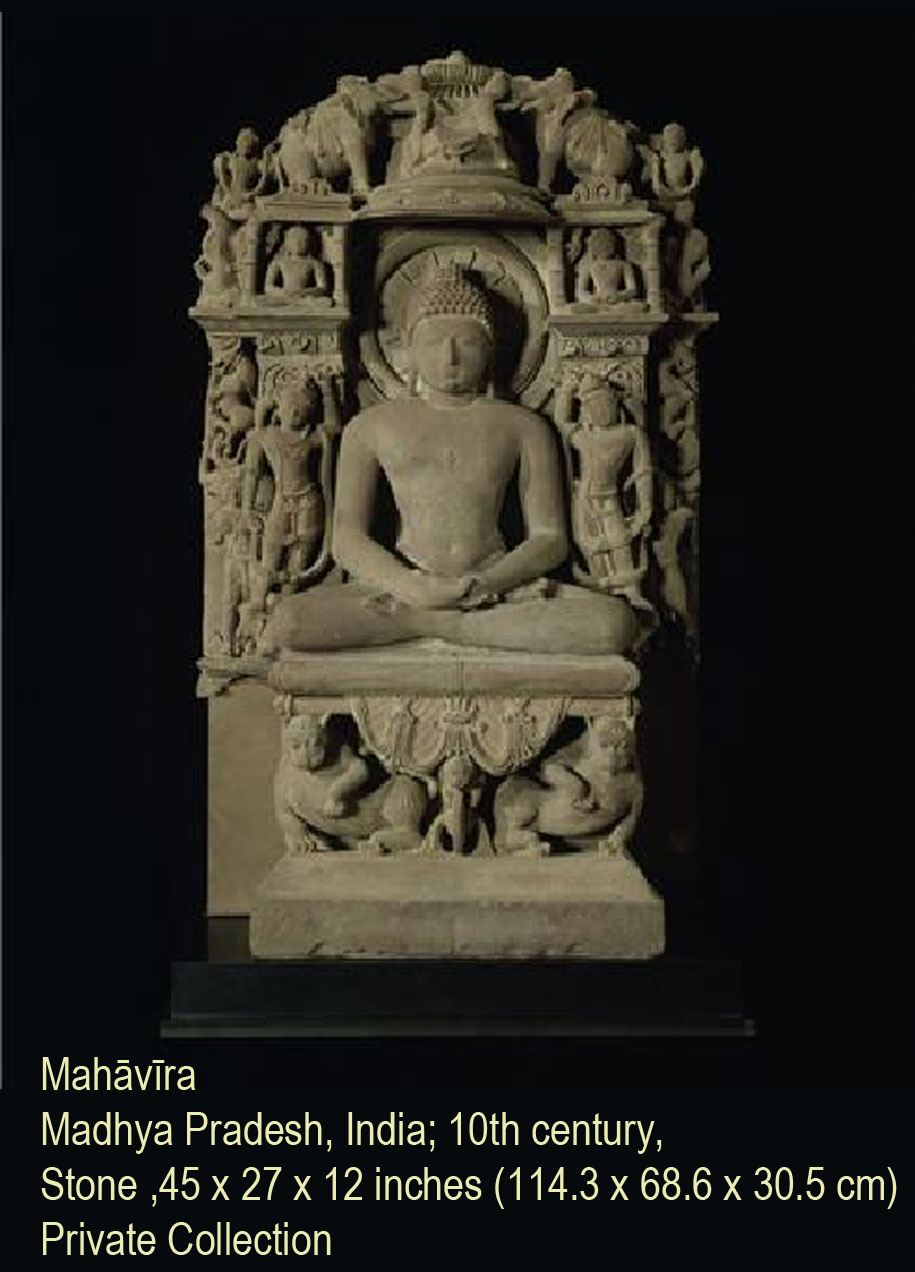
Mr. Rubin has given us perhaps the most exhilarating and audacious art galleries depicting Jain culture, traditions, and historic trails of the Jain people. With his vision, the most graciously received art exhibition in United States most lavishly took place amongst several floors at the Rubin Museum of Art from September 18, 2009 to February 15, 2010. In addition to the generosity of Mr. Rubin, "Victorious Ones: Jain Images of Perfection” was sponsored by Sita & Suman Jain and Family with grants given by Bina & Navin Kumar Jain and the Rubin-Ladd Foundation.
From Mr. Rubin’s perspective, Professor Phyllis Emily Granoff receives high accolades in conducting the vast amount of research, selecting art exhibition theme as well as each art piece, making sure different decades and times were represented in art form by working with other scholars as well as her students.
Professor Granoff is a specialist in Indic religion. She is currently the Lex Hixon Professor of World Religions at Yale University. She also serves as the editor of the Journal of Indian Philosophy, member of Bhandarkar Oriental Institute, the Association for Asian Studies, and the American Academy of Religion. After receiving a Bachelor of Arts (summa cum laude) in Far Eastern Languages from Radcliffe College, she earned her Ph.D. in Sanskrit, Indian Studies, & Fine Arts from the Harvard University. She is fluent in numerous Indian languages including Sanskrit, but also Prakrit, Pali, Ardha Magadhi, Bengali, Hindi, Assamese, Gujarati, and Oriya. She also has some degree of skill in Japanese, Chinese, French, and German.
With her husband Professor Koichi Shinohara, she has also written, translated, and edited several books, and published 70+ journal articles on various topics. She is a scholar of the classical religions of India: Buddhism, Jainism, and Hinduism. Her current research includes several different projects. "I continue to be interested in the origins of puranic I have also been studying Jain monastic codes and medieval Indian law,” said Professor Granoff. Hinduism and early Indian religions.
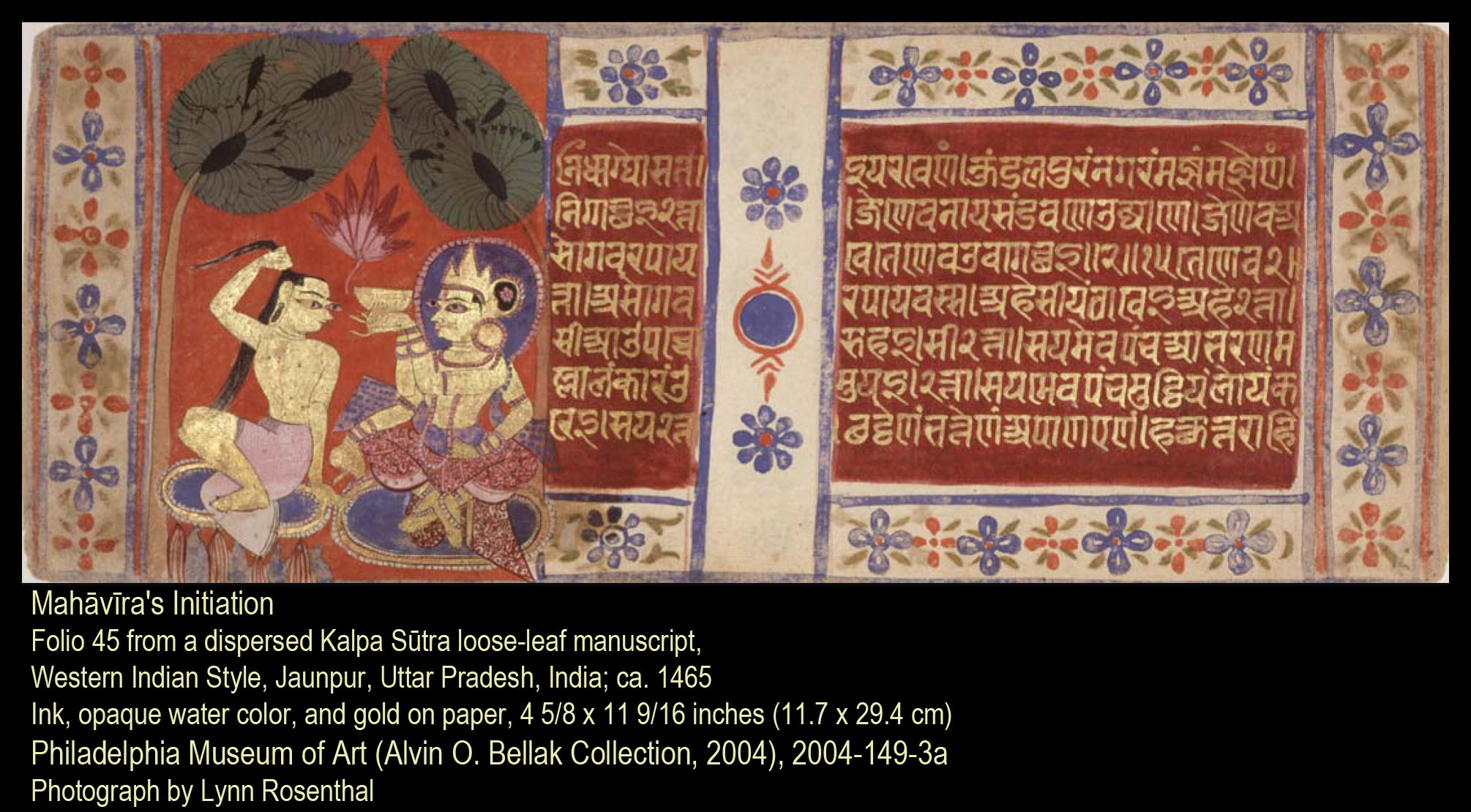
Professor Granoff wanted to bring together Jain images from several centuries to truly understand the origin and meaning of Tirthankaras. "Victorious Ones: Jain Images of Perfection” has been acclaimed as one of the best art exhibitions on Jainism.She commences by describing when Jainism began."Mahavira is the last of the series of Jinas, tirthankars, teachers of the Jain faith in our world cycle. Jains believe in a series of our time cycles of declining prosperity, and in each of those time cycles there are 24 Jinas. In our present time cycle, Mahavira and Parshvanath, the last and next-to-last, are considered by scholars to have been historical figures. The image of the Jina developed at about the same time as images of the Buddha, and we see here a marked similarity in the treatment of the head of the Jina with the treatment of the head of the Buddha.” (Photos of Mahavira sculpture in stone with caption, and painting of Mahavira’s Initiation with caption)
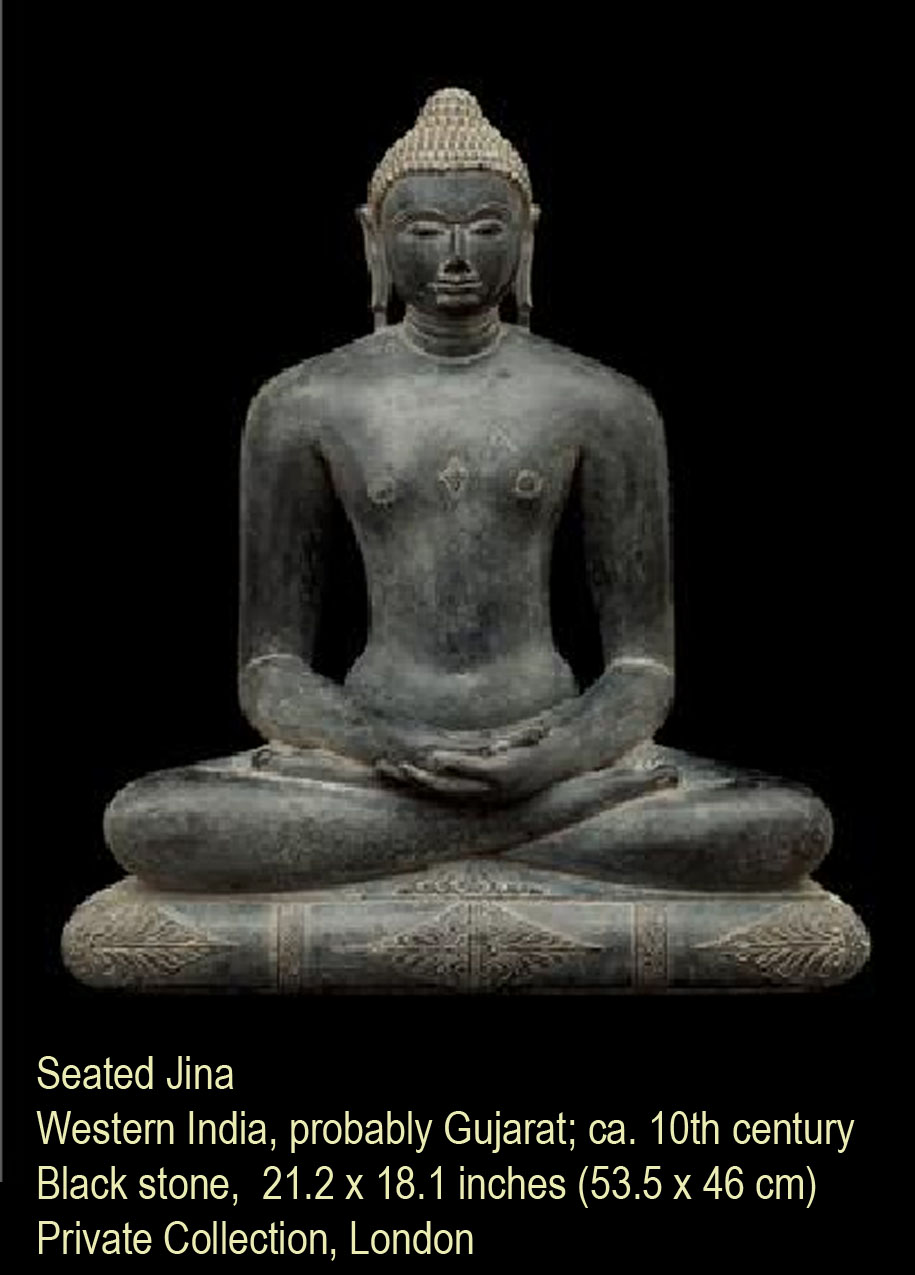
Professor Granoff also displays superb mastery in articulating the influences of time and place on the creation of the black stone sculpture of a Seated Jina. "The pleasing balance of proportions and the soft and supple hands and feet that are not overly stylized point to a date around the tenth century. The round, heart-shaped face has a tranquil and somber expression, and the size and placement of the auspicious mark in the center of his chest accord with those on images made in western and central India, such as the tenth-century bronzes from Akota near Vadodara in Gujarat. The hem of the lower garment subtly fans out over the cushion before him; it indicates that the sculpture was made for a patron belonging to the Śvetāmbara sect.” (Photo of Seated Jina sculpture in stone with caption)
After having received discussions of multiple art pieces displayed amongst this art gallery, perhaps one of my personal favorites is "Diagrams of the Universe: The Two-and-a-Half Continents, the Universe in the shape of a Person, and the Seven Levels of Hell.” It is a cloth painting portraying Jain belief of striving for a pure and nonviolent life with spiritual development and the fundamental principle of actions and their consequences within Jain universe. Professor Granoff describes this art piece, "What’s distinctive about this painting is that it combines the map of the cosmos with the depiction of the entire universe in the shape of a man, often called the "lokapurusa” or "cosmic man.” To the left is Adhaidvipa, the two-and-a-half continents that comprise the world of men. To the right are the seven hells, corresponding to the lower part of the cosmic man.” (Photo of Diagrams of the Universe: The Two and a Half Continents, the Universe in the Shape of a Person, and the Seven Levels of Hell painting with caption)
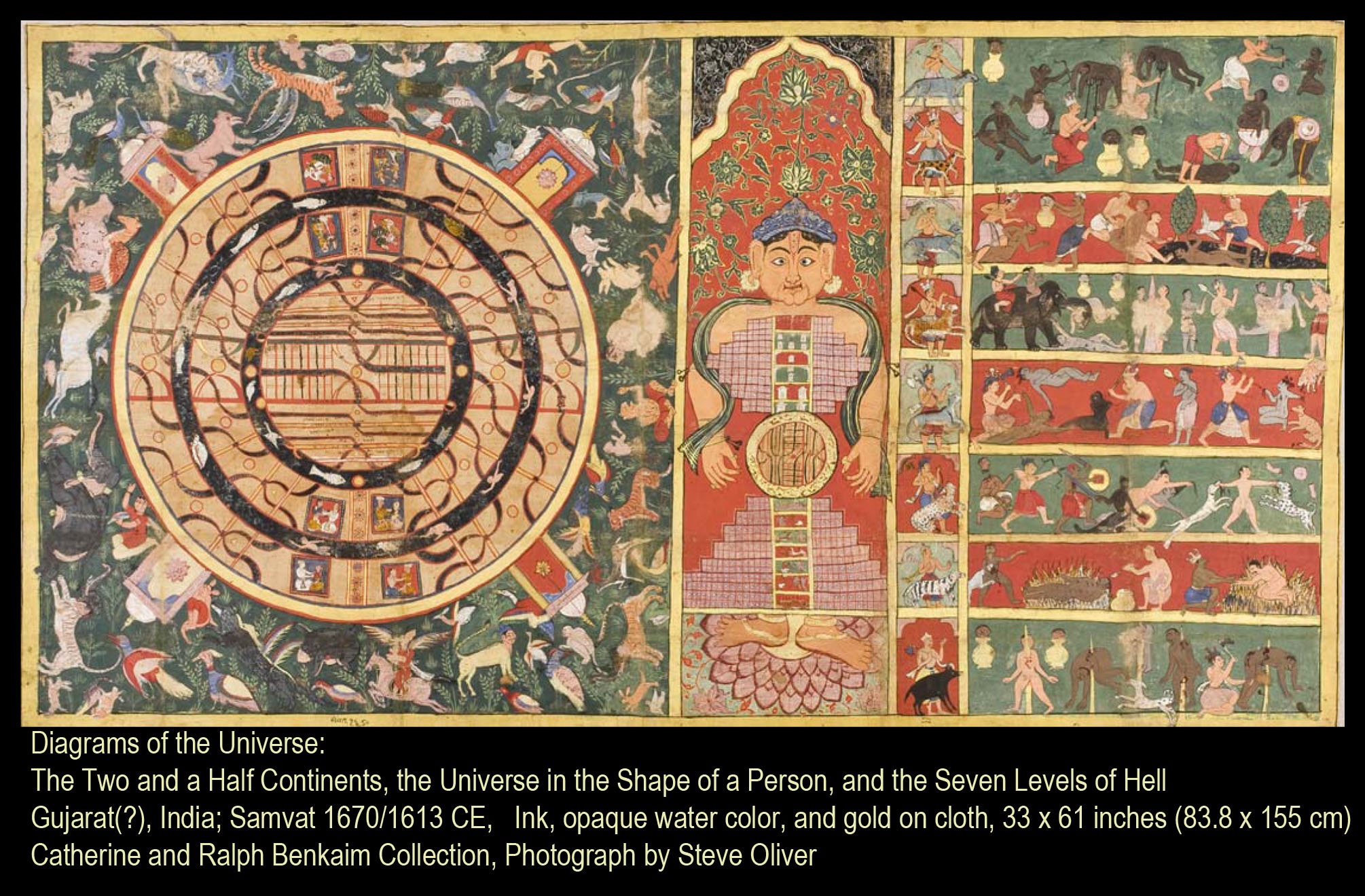
Professor Granoff chose Adhāīdvīpa Pata, the Two-and-a-Half Continents as the cover of her new book, Victorious Ones.She explains the painting as, "The artist has skillfully integrated the different areas of the composition: the elephants between the two women with their blue feet lead the eye downward to the blue rivers of the map, while the flowers the women hold aloft lead to the framing floral border. We find women who are musicians and singers: one holds a musical instrument, while others strike poses of dance. None of the women are exactly like the other. The artist has varied the colors of their clothing and the position of their arms and limbs to make a lively composition that engages us.” (Photo of Adhāīdvīpa Pata, the Two-and-a-Half Continents painting as front cover of article with caption)
We thank Professor Granoff for bringing to the general public her knowledge of and research on Jain pilgrimages, holidays, and Jain universe. She has also brought forward an artistic and scholarly insight in the Jain art form of its temples, sculptures and paintings. The real translations she provides of the Jain Images of Perfection are very astute in giving this generation a higher appreciation of our rich heritage and understanding of the Jain mantras, rituals, and the historicity of our faith. Her new book Victorious Ones discusses the religious philosophies of Jainism and exhibits the exquisite art and culture that has been a part of it. We eagerly await her next endeavor as she continues exploring various aspects of Jainism and in the process enriching all of us in North America.